

Ecolabel Index. WGBC. UKGBC. USGBC. LEED. Know we're back!
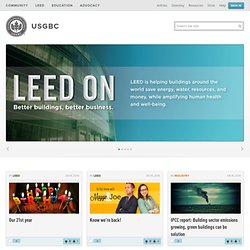
We know. "In The Know" took a several week long — unannounced — hiatus. Maggie and I apologize, but we have been working on a number of international efforts that have kept us occupied! In short, we’re back, so is Mad Men, and we have a tremendous amount to share in the coming weeks. I was in China (my distraction) with some of USGBC's leadership at the end of March for a series of meetings, a plaque presentation and, most importantly, seeing LEED in motion... U.S. Washington, D.C. — (April 10, 2014) — The U.S. 3 billion square feet — but who's counting? At USGBC, we've had no shortage of notable milestones of late. LEED committee self-nominations close on April 10 A reminder for those interested in working with volunteer experts in the development and maintenance of the LEED rating system: The current LEED Committee Call for Volunteers is scheduled to close on Thursday, April 10th at 5:00 pm PST.
UPC. UPC Interactive Master plans Lorem ipsum dolor sit amet, consectetur adipiscing elit.
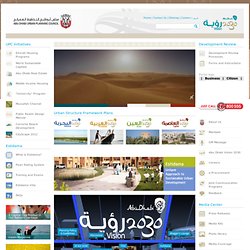
Curabitur velit massa, vehicula vitae pellentesque a, placerat sed est. Integer condimentum suscipit nunc, id feugiat urna euismod ut. Sed neque nulla, ... Shaping your City-Scape (Guidelines and planning process) Lorem ipsum dolor sit amet, consectetur adipiscing elit. Estidama. GBCA Green Star. CASBEE. Measures to Promote Sustainability Buildings, which consume and discard resources and energy in enormous quantities, are one of architectural category which we must act urgently to develop and promote techniques and policies able to assist the drive towards sustainability.
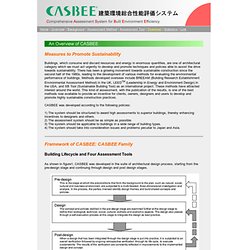
There has been a growing movement towards sustainable construction since the second half of the 1980s, leading to the development of various methods for evaluating the environmental performance of buildings. Methods developed overseas include BREEAM (Building Research Establishment Environmental Assessment Method) in the UK, LEEDTM (Leadership in Energy and Environment Design) in the USA, and SB Tool (Sustainable Building Tool) as an international project. These methods have attracted interest around the world. CASBEE was developed according to the following policies: Framework of CASBEE: CASBEE Family Building Lifecycle and Four Assessment Tools Figure 1. Figure 2. BRE. SAP. Building regulations The 2009 edition of the Standard Assessment Procedure (SAP 2009) applies from October 2010 for compliance with building regulations in England & Wales (Part L) and in Scotland (Section 6), and from 31 October 2012 in Northern Ireland.
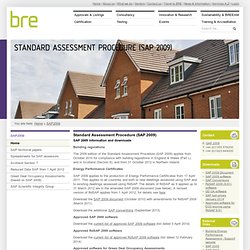
Energy Performance Certificates SAP 2009 applies to the production of Energy Performance Certificates from 17 April 2011. This applies to all countries and both to new dwellings assessed using SAP and to existing dwellings assessed using RdSAP. The details of RdSAP as it applied up to 31 March 2012 are in the amended SAP 2009 document (see below). Download the SAP 2009 document (October 2010) with amendments for RdSAP 2009 (March 2011) SBEM. SBEM is used for non domestic buildings in support of the National Calculation Methodology (NCM), the Energy Performance of Buildings Directive (EPBD) and the Green Deal.
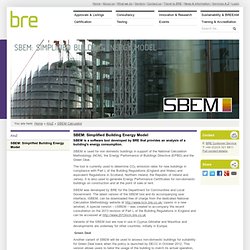
The tool is currently used to determine CO2 emission rates for new buildings in compliance with Part L of the Building Regulations (England and Wales) and equivalent Regulations in Scotland, Northern Ireland, the Republic of Ireland and Jersey. It is also used to generate Energy Performance Certificates for non-domestic buildings on construction and at the point of sale or rent. SBEM was developed by BRE for the Department for Communities and Local Government. The latest version of the SBEM tool and its accompanying user interface, iSBEM, can be downloaded free of charge from the dedicated National Calculation Methodology website at (opens in a new window). BREEAM. CLG CSH. The code for sustainable homes is the national standard for the sustainable design and construction of new homes.
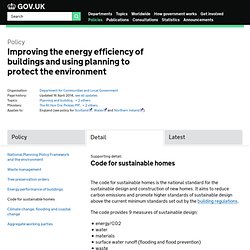
It aims to reduce carbon emissions and promote higher standards of sustainable design above the current minimum standards set out by the building regulations. The code provides 9 measures of sustainable design: energy/CO2 water materials surface water runoff (flooding and flood prevention) waste pollution health and well-being management ecology It uses a 1 to 6 star system to rate the overall sustainability performance of a new home against these 9 categories. Green Guide. PE INTERNATIONAL. CLG. Issue In 2009 buildings accounted for about 43% of all the UK’s carbon emissions.
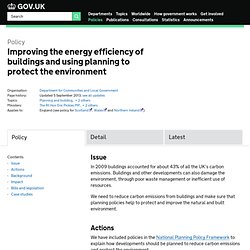
Buildings and other developments can also damage the environment, through poor waste management or inefficient use of resources. We need to reduce carbon emissions from buildings and make sure that planning policies help to protect and improve the natural and built environment. Actions We have included policies in the National Planning Policy Framework to explain how developments should be planned to reduce carbon emissions and protect the environment. To reduce carbon emissions from buildings, we: EST. Zero Carbon Hub. DECC. Skip to main content GOV.UK uses cookies to make the site simpler.
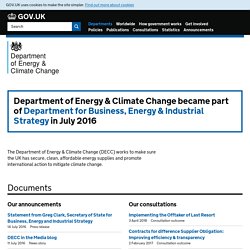
Find out more about cookies Is this page useful? Yes this page is useful No this page is not useful Is there anything wrong with this page? BIS. ASHRAE. Atelier Ten. Aecom. Mott MacDonald. Policy Exchange. CIOB Funding Matrix. MBEKTN.